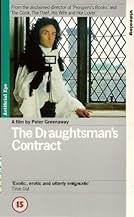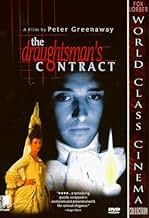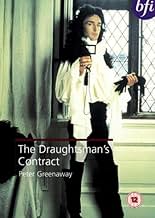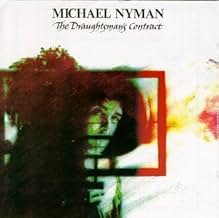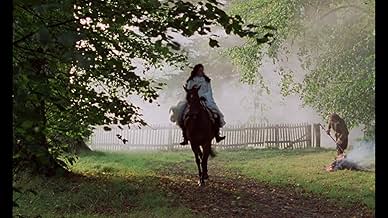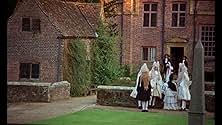IMDb-BEWERTUNG
7,2/10
11.727
IHRE BEWERTUNG
Ein junger Künstler wird von der Frau eines wohlhabenden Landbesitzers beauftragt, während der Abwesenheit ihres Mannes eine Reihe von Zeichnungen des Nachlasses anzufertigen.Ein junger Künstler wird von der Frau eines wohlhabenden Landbesitzers beauftragt, während der Abwesenheit ihres Mannes eine Reihe von Zeichnungen des Nachlasses anzufertigen.Ein junger Künstler wird von der Frau eines wohlhabenden Landbesitzers beauftragt, während der Abwesenheit ihres Mannes eine Reihe von Zeichnungen des Nachlasses anzufertigen.
- Regie
- Drehbuch
- Hauptbesetzung
- Auszeichnungen
- 1 Gewinn & 4 Nominierungen insgesamt
Anne-Louise Lambert
- Mrs. Talmann
- (as Anne Louise Lambert)
Nicholas Amer
- Mr. Parkes
- (as Nicolas Amer)
Lynda La Plante
- Mrs. Clement
- (as Lynda Marchal)
Alastair G. Cumming
- Philip - Mr. Neville's assistant
- (as Alastair Cummings)
Empfohlene Bewertungen
This is a most intricately structured enigma of a film, one that seems on the surface to be ordinary, but underneath has many layers that need examining in detail from several viewings. The story is set in the English countryside in 1694. The prominent character is a draughtsman named Mr. Neville, who is asked by a lady named Mrs. Herbert to make twelve drawings of her house from different angles. He agrees, as long as he can have the lady for his intimate pleasure.
Mr. Neville is a perfectionist, and very meticulous in his drawings. He states to everyone at the house all his rules about everything that has to remain in the same place while he draws. The film moves along nicely, everything seems usual, then events start to become strange. Stone statues start to move around, and take up different locations to contort into another static pose. Objects start to change location to confuse Mr. Neville in his drawings. Then Mrs. Herbert's daughter approaches Mr. Neville and tells him her father may have been murdered. She says she has evidence to indict Mr. Neville of his murder, and blackmails him, requesting his service for her sexual needs. Then Mr. Herbert's body is found in a ditch and things get even more complex.
This film is one of those that you need to watch and try and unravel yourself. To try to do that here in this review is almost impossible. I recommend it. It is exquisitely performed and filmed. The costumes are good. The speeches by the cast are delivered in a grandiose and statement-like manner. The music is appropriate. A classic piece of puzzling cinema that will have you watching it many times.
Mr. Neville is a perfectionist, and very meticulous in his drawings. He states to everyone at the house all his rules about everything that has to remain in the same place while he draws. The film moves along nicely, everything seems usual, then events start to become strange. Stone statues start to move around, and take up different locations to contort into another static pose. Objects start to change location to confuse Mr. Neville in his drawings. Then Mrs. Herbert's daughter approaches Mr. Neville and tells him her father may have been murdered. She says she has evidence to indict Mr. Neville of his murder, and blackmails him, requesting his service for her sexual needs. Then Mr. Herbert's body is found in a ditch and things get even more complex.
This film is one of those that you need to watch and try and unravel yourself. To try to do that here in this review is almost impossible. I recommend it. It is exquisitely performed and filmed. The costumes are good. The speeches by the cast are delivered in a grandiose and statement-like manner. The music is appropriate. A classic piece of puzzling cinema that will have you watching it many times.
Being of English origin the film has a particular fascination. Certain things become apparent if you know England well, but also I suspect on repeated viewing.
A tale of conceit, deception and power. The conceit of the Draughtsman, all too apparent, is matched by the conceit of the upper classes as the film unfolds. The pictoral conceit referred to in the film repeatedly is matched by a pictoral conceit played on the viewer: the wigs were never that big, the house, garden and grounds stunning and the weather too perfect.
Deception exists at many levels. The viewer is deceived as to where the houses and events take place. The allusions are to Southampton and surrounding areas. Being from the Southampton area I realized this wasn't Southampton. Though it could possibly have been. The deception was convincing. The location is Kent. I believe this deception, which fits so nicely in the film anyway, was pulled so that the owner of the house where the film is centred around would not be invaded by tourists. A nice touch which I suspect follows the line in the film, something like this), "Do you think Mrs Talbot is a lady who likes her gravel being kicked around by a pack of dogs."
The arrogance and exploitation of the ladies of the house by the Draughtsman, readily apparent, is more sinisterly exceeded by the arrogance and exploitation of the Draughtsman by the ladies. The Draughtsman provides a cover for murder, solves the problem of transfer of the property by siring a child and finally ends up as the scapegoat for murder. While the Draughtsman may appear to be playing with the household for his own amusement, the Draughtsman himself is the focus of a much more brutal and more deadly game.
Like all the best films there is much going on in the film. The lines and language are wonderfully rich. The camera merely shows you the events. And it is not above deceiving you as a viewer. Trying to make sense of it all is great fun. Many things I didn't even see until the second or third viewing, let alone make sense of them!
A beautiful allegory which slowly unfolds and challenges the senses. Much like The Prisoner (1967) tv series, and hopefully The Prisoner (2000) movie.
A tale of conceit, deception and power. The conceit of the Draughtsman, all too apparent, is matched by the conceit of the upper classes as the film unfolds. The pictoral conceit referred to in the film repeatedly is matched by a pictoral conceit played on the viewer: the wigs were never that big, the house, garden and grounds stunning and the weather too perfect.
Deception exists at many levels. The viewer is deceived as to where the houses and events take place. The allusions are to Southampton and surrounding areas. Being from the Southampton area I realized this wasn't Southampton. Though it could possibly have been. The deception was convincing. The location is Kent. I believe this deception, which fits so nicely in the film anyway, was pulled so that the owner of the house where the film is centred around would not be invaded by tourists. A nice touch which I suspect follows the line in the film, something like this), "Do you think Mrs Talbot is a lady who likes her gravel being kicked around by a pack of dogs."
The arrogance and exploitation of the ladies of the house by the Draughtsman, readily apparent, is more sinisterly exceeded by the arrogance and exploitation of the Draughtsman by the ladies. The Draughtsman provides a cover for murder, solves the problem of transfer of the property by siring a child and finally ends up as the scapegoat for murder. While the Draughtsman may appear to be playing with the household for his own amusement, the Draughtsman himself is the focus of a much more brutal and more deadly game.
Like all the best films there is much going on in the film. The lines and language are wonderfully rich. The camera merely shows you the events. And it is not above deceiving you as a viewer. Trying to make sense of it all is great fun. Many things I didn't even see until the second or third viewing, let alone make sense of them!
A beautiful allegory which slowly unfolds and challenges the senses. Much like The Prisoner (1967) tv series, and hopefully The Prisoner (2000) movie.
Peter Greenaway's first commercially released feature film is a calling card of dazzling virtuosity.
Peter Greenaway's smart, outrageous, and utterly original historic movie is part comedy of manners and part murder mystery, as a late 17th century draughtsman (Anthony Higgins) is tasked with producing a series of drawings for the Herbert family estate by the lady of the manor (Janet Suzan) in order to please her husband, but he ends up pleasing himself with both Mrs Herbert and her daughter (Anne-Louise Herbert), before the husband is found dead in the moat and he becomes prime suspect in his murder. This was Greenaway's first conventional feature film, it shows him at his best and most playful, and is a calling card of dazzling virtuosity. The original cut ran in excess of three hours but was edited down to 103 minutes for release to make it easier to watch. It is still a puzzle box of a movie and a real strange delight though, featuring elaborate and slightly exaggerated (for eye catching effect) period costumes, a wonderful score by Michael Nyman which borrows widely from Henry Purcell, that reflects the period setting whilst managing to rock with a vengeance, and a 'living statue' that roams the garden unseen to all but children, it is a movie that you won't forget in a hurry. Incidentally, Greenaway trained as an artist before he became a filmmaker, and the hands seen drawing in the film are his own, as are the completed drawings.
There is no need to hate this movie. It's quite enjoyable by itself. It doesn't require any heavy intellectual digging or background instruction manual to appreciate. Plus, it's quirky comedy is being taken as mysterious and dark. Please! Just enjoy it and laugh. The humor is irksome but funny. It's like a bit of Shakespeare. It has meaningful plot and fun dialogs. The guy who wrote the review centering on the Draughtsman's "arrogance and innocence "(a dangerous combo!) had it spot on, and this personality flaw is key to the plot. Thoroughly enjoyable and funny and clever. Architects everywhere, TAKE COVER! LOL.
Mr. Neville is a young arrogant artist full of himself. He is contracted to make landscape estate drawings by Mrs. Virginia Herbert. She has a bitter relationship with her wealthy landowning husband who leaves on a trip. She submits to Neville sexually as part of the contract. There is also her daughter Mrs. Talmann and her husband Mr. Talmann. The couple is childless taking care of his nephew. Mrs. Herbert tries to revoke the contract but Neville refuses. Mrs. Talmann blackmails Neville into entering a similar contract pointing out items in his drawings which indicate "misadventure". When Mr. Herbert is found dead in the moat, Neville is horrified to discover that he's the leading suspect.
This is an unusual film. It's a Shakespearian sex romp with a murder mystery. The style has long takes and mid to long distance visuals. The movie lost me the first time around. It can meander and the story can be mercurial. It would help a lot if the murder is shown even if the perpetrators are not. The individual clues need accompanying flashbacks to show that part of the crime. This has a certain amount of beauty and weird originality but it's not easy for everyone.
This is an unusual film. It's a Shakespearian sex romp with a murder mystery. The style has long takes and mid to long distance visuals. The movie lost me the first time around. It can meander and the story can be mercurial. It would help a lot if the murder is shown even if the perpetrators are not. The individual clues need accompanying flashbacks to show that part of the crime. This has a certain amount of beauty and weird originality but it's not easy for everyone.
Wusstest du schon
- WissenswertesDirector Peter Greenaway, a former art student, created the sketches that feature in the film. In fact the close-up shots of the draughtsman drawing are of his hands.
- PatzerThe cooing of a collared dove is not a sound that would have fallen on Jacobean ears, as the species was unknown in Britain until 1955.
- Zitate
Mr. Neville: You must forgive my curiosity, madam, and open your knees.
- Alternative VersionenWhen Peter Greenaway screened the movie at festivals in 1982, it ran a full three hours. Included in this footage is a full and further explained rationale for the moving statue.
Top-Auswahl
Melde dich zum Bewerten an und greife auf die Watchlist für personalisierte Empfehlungen zu.
- How long is The Draughtsman's Contract?Powered by Alexa
Details
- Erscheinungsdatum
- Herkunftsland
- Sprachen
- Auch bekannt als
- The Draughtsman's Contract
- Drehorte
- Produktionsfirmen
- Weitere beteiligte Unternehmen bei IMDbPro anzeigen
Box Office
- Budget
- 320.000 £ (geschätzt)
- Bruttoertrag in den USA und Kanada
- 2.256.246 $
- Weltweiter Bruttoertrag
- 2.283.233 $
Zu dieser Seite beitragen
Bearbeitung vorschlagen oder fehlenden Inhalt hinzufügen




